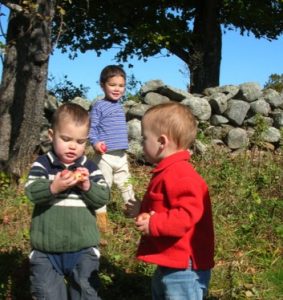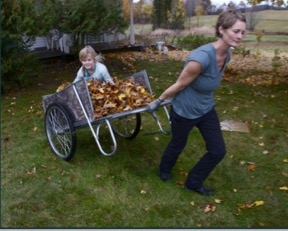Keep Kids Safe on the Farm with Universal Design
By Ellen S. Gibson
Farms are wonderful places for kids to explore, to experience nature, to follow their curiosity, to learn about responsibility. Many farms are multi-generational. Often, farms invite visitors, for you-pick operations, Open Farm Day, or other events.
How do ensure the farm is a safe place for kids to be?
Universal Design Principles
Flexibility in use: If your barn will be accessible to small children, is it also a space where less mobile adults can easily supervise their children or grandchildren?
Tolerance for error: There are areas on your farm where there is NO TOLERANCE FOR ERROR. Examples include chemical storage, where machinery is stored or in use, access to grain bins, hay mows, ladders. These areas need to be physically removed, locked, and clearly marked as off-limits to the public.
Perceptible information: Is there clear signage to show adults where kids can and cannot go? Are indoor spaces well-lighted?
Simple and Intuitive use: It’s intuitive for kids to want to touch things, to put berries in their mouths for a taste-test. A garden where children can play should have no thorns or poisonous plants.
Equitable Use: A playground or children’s garden–or any other places on a farm that children can access- needs paths and gates to accommodate all ages, whether it is an adult walking hand-in-hand with a child, or using a stroller, wheelchair, or walker.
Consideration of all ages and developmental stages
Match your expectations of children with their developmental stage.
- Are you asking too much? Expecting young children to do something beyond their ability is unsafe. For example, a child under the age of 12 does not yet have the eye/hand coordination to drive a tractor safely.
- Are you modeling safe behavior? Never allow a child as an extra rider on a tractor.
In the kitchen: Visiting children will not usually have access to the kitchen, but it is often the hub for family activities. Kids love to cook. How can you prevent burns, cuts, and unfortunate accidents?
- Knobs on the stove are located on the back so that they are not turned on accidentally
- A sturdy two-step ladder provides a safe stand for young helpers. Workspaces can be designed at various heights to accommodate children and they can sit and work at a table.
- Good lighting is easier on the eyes and prevents tripping over something that has fallen to the floor.
Around the farm:
- Good latches on gates and stall doors ensure animals will be contained. Physical barriers keep children away from machinery and other hazards.
- Public access/areas open for children are fenced and clearly marked with signage.
- Areas with animals are clearly delineated. Fences keep children safe with animals are on one side and children are on the other. With visiting children, it’s important to keep track of your dogs and may be necessary to keep them fenced.
- Electrified fences are clearly labeled.
- Machinery is turned off when not in use. Hydraulics are lowered. Keys are removed.
Nature trails:
- Good signage: provides safe guidelines to know where to go and where not to go and clearly designates pathways, entries, exits, directional information.
- Benches provide places to rest.
- Interpretive signs help orient people to place and surroundings.
- Well-marked trails and maps help keep people from getting disoriented or lost.
Around Farm Ponds:
- Farm ponds are fenced with clear signage about rules and hazards.
- Children are supervised at all times. Rules are discussed ahead of time and are enforced.

Make a farm experience one of shared wonder and curiosity.
Diligent adult supervision is required at all times. Applying a Universal Design lens to safety on the farm can keep the experience as a cherished memory.
Additional information:
- Child Development and Farm Safety: www.childagsafety.org
- Universal Design: “Work Smarter not Harder on the Farm with Universal Design Principles,” March 24, 2020, https://extension.umaine.edu/agrability/2020/03/24/work-smarter-and-safer-on-the-farm-with-universal-design-principles/

